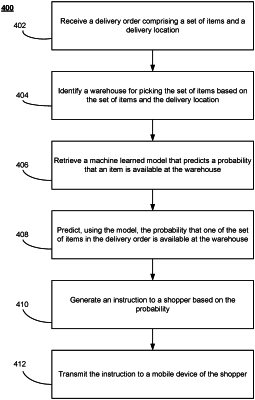| CPC G06Q 30/0635 (2013.01) [G06Q 30/0639 (2013.01)] | 20 Claims |

|
1. A method comprising:
receiving, at an online concierge system, an order comprising a plurality of items and a delivery location, wherein the received order is completed at an ordering interface of the online concierge system, and the ordering interface displays items that have discrepancies in availabilities compared to actual availabilities of the items at a warehouse;
identifying, by the online concierge system, the warehouse for picking the plurality of items based on the items in the received order and the delivery location;
identifying, by the online concierge system, a difficult-to-find item in the items in the received order, wherein the difficult-to-find item is an item that was not found by at least a threshold number of other shoppers at the warehouse within a specific time interval;
training, by the online concierge system, a machine-learned availability model, wherein training of the machine-learned availability model comprises:
applying a plurality of training datasets to train the machine-learned availability model, the plurality of training datasets comprising previous delivery orders, wherein at least one training dataset of an item comprises a training label of whether the item was picked and a plurality of characteristics associated with the item;
retraining, by the online concierge system, the machine-learned availability model, wherein retraining the machine-learned availability model comprises:
inputting factors for an item-warehouse pair into the machine-learned availability model, the item-warehouse pair corresponding to a specific item, wherein the machine-learned availability model generates a confidence score indicative of an accuracy of a prediction of availability of the specific item;
in response to the confidence score indicative of the accuracy of the prediction of availability of the specific item being below a threshold, sending instructions to a first client device of a first shopper, the instructions comprising having the first shopper to attempt to find the specific item and to collect new information about the item;
receiving, from the first client device, a result of the attempt to find the specific item and new information about the item;
updating a training dataset of the plurality of training datasets to include the new information and the result, wherein the new information is used as the factors of the item-warehouse pair and wherein the result of the attempt to find the specific item is used to update the training dataset to include an indication of the availability of the specific item in the warehouse and a corresponding time of the result; and
retraining the machine-learned availability model on the updated training dataset;
using, by the online concierge system, the machine-learned availability model to predict an availability score of the difficult-to-find item, the availability score corresponding to a probability that the difficult-to-find item is available at the warehouse;
determining, by the online concierge system, that the availability score associated with the difficult-to-find item generated by the machine-learned availability model is higher than an availability threshold;
receiving, at the online concierge system, information from a second client device of a second shopper fulfilling the received order at the warehouse, the information identifying items that the second shopper has obtained from the warehouse, wherein the identified items does not contain the difficult-to-find item;
transmitting, by the online concierge system, a notification to the second client device of the second shopper that the difficult-to-find item is likely available at the warehouse;
receiving, by the online concierge system from the second shopper, an indication that the second shopper has obtained the difficult-to-find item from the warehouse;
determining, by the online concierge system, that the second shopper satisfies a threshold amount of criteria maintained by the online concierge system, wherein at least one of the criteria specifies that the second shopper has completed an additional order within a specified time interval of obtaining the difficult-to-find item from the warehouse;
prompting, by the online concierge system, the second shopper to provide information for finding the difficult-to-find item in the warehouse through an interface displayed to the second shopper via a shopper mobile application executing on the second client device in response to (a) that the second shopper has obtained the difficult-to-find item from the warehouse and (b) that the second shopper satisfies the threshold amount of the criteria; and
receiving, by the online concierge system, from the shopper who has obtained the difficult-to-find item, the information for finding the difficult-to-find item;
adding, by the online concierge system, to the plurality of training datasets for further retraining of the machine-learned availability model, the information for finding the difficult-to-find item received from the second shopper at the online concierge system in association with the difficult-to-find item and in association with the warehouse.
|